
|
|||||
|---|---|---|---|---|---|

|
|||||
DisposableDiapers
by The Canadian Cloth Diaper Association
|
Let's not throw the baby out with the diapers. |
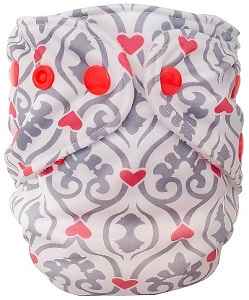
FuzziBunz Perfect Size Diaper |
The cloth vs. disposable
diaper debate has become more and more complex, but it doesn't have to be.
In this article, you'll find THE FACTS and a comparison of direct quotes from both sides. Make your decision an informed choice.
Here are some points to consider . . .
Cloth diapers aren't what they used to be! Now they are pinless and painless.
Innovative designs in fitted diapers and Velcro®-closing covers make modern cloth diapering equivalent to disposables
in convenience.
The fit, the comfort and the leak guards are all there for your baby's cotton comfort. Plus cloth diapers are breathable, and chlorine-free.
Diaper services even deliver and pick-up at your door! Are disposables
that convenient?
The most common cause of rash is extended exposure to a hot soiled diaper.
A disposable
diaper hides evidence that the diaper needs to be changed, often resulting in bacteria-caused rashes.
Disposables
will hold about 7 pounds of fluid, but how long do you want your child in a used diaper?
A dirty diaper is a dirty diaper, and should be changed to prevent bacterial infections.
Non-absorbent liners can be used in cloth diapers to keep baby's bottom drier, and also make rinsing unnecessary.
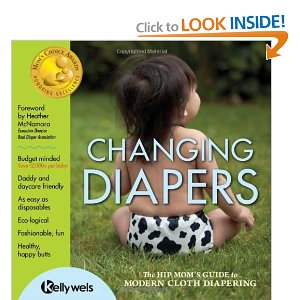
Changing Diapers: The Hip Mom's Guide to Modern Cloth Diapering |
Disposable
diapers are the most expensive diapering method. Diaper service will save you about $1,200, and washing your own will save you about $1,800.
Disposable
diapers contain trace amounts of the carcinogen DIOXIN, as well as large amounts of chemicals for absorbency and perfumes.
Cloth diapers are natural fibres and, if washed professionally, they will have the proper Ph and no chemical residues.
You have probably seen advertising which states that disposables
are as gentle to the environment as cloth, but are they really?
Not according to Environment Canada . . .
Not according to Canadian environmental groups . . .
Not according to your common sense . . .
Here's what each side has to say on the issues . . .
Disposable
diaper manufacturers state:
Clinical studies have shown less diaper rash with Pampers® than with cloth.
-- source: Proctor and Gamble, Diapers and the Environment, 1991
Objective reports state:
Numerous studies have failed to show that diaper rash is any more common in healthy babies using cotton diapers.
Babies may get a rash from the perfumes in some (disposable) diapers.
-- source: the Toronto Board of Health, The Diaper Decision, October 1990
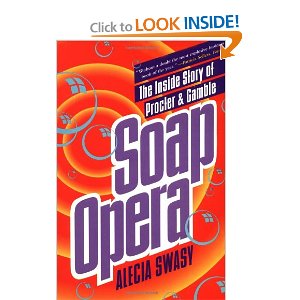
Soap Opera: The Inside Story of Procter and Gamble |
Disposable
diaper manufacturers state:
If you weigh one against the other, there is no environmental winner.
and
It's six of one, half a dozen of the other.
-- source: Proctor and Gamble. Pampers® print ad, 1991
Objective reports state:
Cloth diapers have already been recognized by Environmental Choice (Environmental Canada) as offering environmental advantages when compared with 'disposable' diapers.
(1)
Using diaper services makes them even better.
Cloth diapers are eligible for the Ecologo provided they are home washable and 100% reusable.
(2)
-- source: (1) Environment Canada, Environmental Choice Guide-lines for Diaper Services
(2) Environment Canada, Reusable Cloth Diapers, 1990
Disposable
diaper manufacturers state:
Disposable diapers account for approximately 2% of the solid waste that goes into landfills.
-- source: Kimberly-Clark, Huggies Diapers and the Environment.
Objective Reports state:
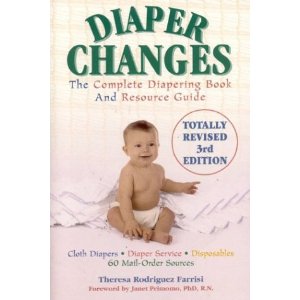
Diaper Changes: The Complete Diapering Book and Resource Guide |
Disposable diapers make up at least 15% of municipal solid waste after 'blue box 2000' items and yard waste are removed.
(1)
They represent the 3rd largest single item (after newspapers and beverage and food containers) in the municipal solid waste stream.
(2)
The average child uses close to 5,000 diapers
(3)
It takes 440 to 880 pounds of fluff pulp and 286 pounds of plastic (including packaging) per year to supply one baby with disposable diapers.
(2)
-- source: (1) Ontario office of Waste Reduction educational material April/92 (Centre and South Hastings office)
(2) Environment Canada, Reusable Cloth Diapers, 1990
(3) John Krauser, Associate director, Ontario Medical Association, Letter to the Toronto Board of Health, April 12, 1991.
Disposable
diaper manufacturers state:
Cloth diapers consume 4 times more water and produce more sewage
(than disposables).
-- source: Proctor and Gamble, Diapers and the Environment, 1991
Objective reports state:
Single-use diapers use 37% more water than home laundered or diapers service laundered reusables.
(1)
Disposables appear to produce less sewage because in them, human waste goes to the dump sites.
This practice violates World Health Organization guide-lines and is technically illegal.
Another consideration is that the wastewater from washing cloth diapers is relatively benign,
while the wastewater from pulp, paper and plastics contain solvents, sludge, heavy metals, unreacted polymers, dioxins and furans.
. (1)
The potential environmental impacts of the disposal of these materials are considerable
-- source: (1) Lehrburger, Mullen, James, Diapers: Environmental Impacts and Lifecycle Analysis, January 1991
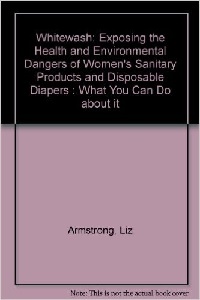
|
Disposable
diaper manufacturers state:
Home laundered diapers use 2 times more energy
(than disposables).
-- source: Proctor and Gamble, Diapers and the Environment, 1991
Objective reports state:
Single-use (disposable) diapers consume 70% more energy than the average reusable diaper per diaper change.
-- source: Lehrburger, Mullen, Jones, Diapers: Environmental Impacts and Lifecycle Analysis, January 1991
Disposable
diaper manufacturers state:
Home laundered diapers create two times more air emissions
(than disposables).
-- source: Proctor and Gamble, Diapers and the Environment, 1991
Objective reports state:
In total, cloth diaper use emits more air pollution.
However, the air pollution from the manufacturer of disposable diapers is far more noxious.
Pulp bleaching emits dioxins and furans into the air, as does incineration.
-- source: Lehrburger, Mullen, Jones. Diapers: Environmental Impacts and Lifecycle Analysis, January 1991
Disposable
diaper manufacturers state:
Disposable diapers are 80% compostable.
(1)
A demonstration project in St. Cloud, Minnesota sponsored by Proctor and Gamble showed that soiled disposable diapers
(2)
can be composted effectively in a municipal composter.
-- source: (1) Proctor and Gamble. Pampers® print literature, 1991.
(2) Proctor and Gamble. Questions and Answers, Paper Diapers and Briefs, 1991
Objective reports state:
Significant composting facilities do not exist in Canada. An alternative to composting is recycling, which was tried in Seattle in 1991.
(1)
That study concluded recycling of this single item would not be economically feasible at any scale. Taxpayers money would be mis-spent in any recycling attempt.
-- source: (1) Seattle Solid Waste Utility. Letter to project participants, December 12, 1991
FOR MORE INFORMATION:
The Canadian Cloth Diaper Association (CCDA), 1537 Welch Street, North Vancouver, B.C. V7P 1B5.
The CCDA is a federally incorporated non-profit organization whose mandate is:
To educate the public about the advantages of cloth diapers and to encourage their use, in order to reduce landfill pollution, preserve our forests and avoid risks to our children's health.
This article compliments of Born to Love.
Send questions, comments, and suggestions to: catherine@borntolove.com
Born to Love articles are written by Catherine McDiarmid-Watt
Born to Love is a participant in the Amazon Services LLC Associates Program, an affiliate advertising program designed to provide a means for sites to earn advertising fees.
NOTE: All logos, company names, brands, images, trademarks and other intellectual property are the property of their respective owners.
Born to Love is a participant in the eBay Partner Network, an affiliate advertising program designed to provide a means for sites to earn advertising fees by advertising and linking to eBay.com.
Copyright © 1978 - BorntoLove.com - All Rights Reserved.
Last updated - April 5, 2024